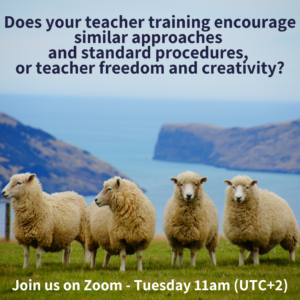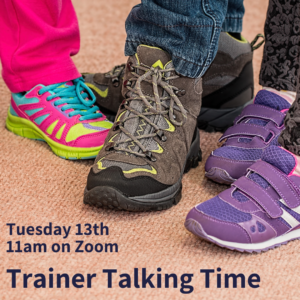These were the sub-questions we shared in case people needed a starting point, but it was great to see how conversations developed naturally in groups as well:
- When we’re thinking about training staff we’re working with, how much does it depend on the teachers you are working with and how much is school policy? If it was just down to you, what would you do?
- For teacher training courses (like Cert/DipTESOL or CELTA/DELTA), the scope of many initial teacher training courses can be limited, what can we do to push certain trainees further while at the same time helping others reach minimal levels?
- Thinking about initial teacher training courses as well – and leading on from Jason Anderson’s talk with DublinTEFL last week – should trainees be limited to a particular teaching model on a course? What are the pros and cons of introducing them to different approaches?
It was really interesting to get perspectives from different contexts: in-house trainers, those involved in pre-service qualifications as freelancers and those who train with one centre, trainers who have experience working with teachers around the world or in different contexts such as CLIL and EAP.
Experience
One area we chatted about was teachers’ motivation to develop; some people said they found new teachers were more open to professional development, whilst those with more experience were less motivated to attend training courses or sessions.
We also spoke about how it can sometimes be challenging to work with experienced teachers on a pre-service qualification (or indeed on a further qualification) as sometimes people can be less open to change. It can also be difficult for people who have been teaching for a number of years to then be observed and have their approaches and delivery critically assessed. It’s essential that we acknowledge people’s prior experience and approach feedback carefully.
Another challenge mentioned around working on a pre-service qualification was finding the balance of pushing stronger trainees whilst supporting those who need it, and we talked about the fact that trainees will often compare themselves to each other and need to be encouraged to focus on their own progress.
Thinking as well about initial training, that it may be very different to how you were taught at school – both in terms of how you’re expected to approach the content as well as the methodologies you’re being encouraged to use.
Communication
A key area which was discussed in relation to being a freelance trainer was in the centre communicating their values and beliefs – though it’s equally true that a centre should share their fundamental principles with any trainers they employ. One person mentioned not wanting to feel they were “selling their soul as a trainer” if they were asked to train in a way which was contrary to their beliefs. There was a brief bit of amusement as we shared some of our training pet peeves – things which are often demonstrated on courses to raise trainees’ awareness of certain things but which can easily be overdone (the main two mentioned were ICQs and eliciting).
We talked about how it can cause unnecessary stress for a trainee to get mixed messages about approaches to learning and teaching if trainers have different views on a topic. For example, if one trainer tells a group of trainees that they shouldn’t pre-teach lexis and then another trainer demoes a lesson pre-teaching lexis, it gives trainees a mixed message. It’s essential that we highlight to teachers that there are different ways of doing things – and this applies not only to approaches, methods and frameworks, but also thinking about how we might do things differently in an online class compared to a socially-distanced class.
Coursebooks
Most initial training courses will have trainees follow a coursebook and we talked about how it’s important that teachers know how to use them effectively – critical SAS (select, adapt, supplement), identifying what each part of the coursebook page is doing and knowing what could be used as a lead-in and where there is scope to personalise the language.
As trainers, we all tend to be quite prescriptive at the start of our courses, allowing trainees more freedom in their planning as the course progresses and, thinking about using different frameworks during a pre-service qualification, we discussed how difficult it can be for teachers to see them in action. This was particularly true for trainers who work in centres which have 40-minute lessons.
Adding to the chat around frameworks, there was some discussion over whether trainees get a little overwhelmed by being shown different teaching models in such a short amount of time.
In-house development through Covid
There was a sense that many teachers aren’t feeling inspired to attend training this year. “We just want to get through it” was a feeling mentioned, as well as the fact that teachers were forced to develop their teaching skills so much last year that they’re less inclined to do further development this year. There was again the sense of Zoom fatigue but also the stresses of being back in the physical classroom – remembering all the various protocols which are in place, honing emotional intelligence, working with windows open and the strain on the voice of teaching wearing a mask and in a classroom where learners are often speaking more loudly than before as they are socially-distanced. Also the fact that many of the things we did intuitively in the past have had to be reimagined; in all, it felt for some that Covid had taken the fun out of teaching.
Thinking as well about in-house development, questions came up which might be more suited to the Management Meet Up around the obligation to provide development for teachers or the obligation to attend in-house development. There’s so much available online now – often giving teachers the flexibility to watch recorded sessions in their own time. Furthermore, some people mentioned that difficulty of bringing people together and not just with social distancing regulations, but also in terms of finding a time which works for everyone’s schedule, especially in bigger schools or in contexts where people work in different places.
One member mentioned that teachers at the schools she’s at are required to complete a minimum number of hours CPD – but that this can be in-house, attending conferences or online sessions. For this school, the system is based on trust and teachers don’t need to provide evidence of the professional development they’re doing.
There was also a question around in-house development of who decides the topics to be covered: is it top-down with management saying, “This is what we’ll be doing”? Or are teachers asked at the start of the year or during appraisals what they would like to focus on?
Thanks everyone for coming!
Final thought…we didn’t discuss specific frameworks during the morning, but if you didn’t get a chance to attend Jason Anderson’s talk on lesson planning frameworks from DublinTEFL, I recommend giving it a watch.

